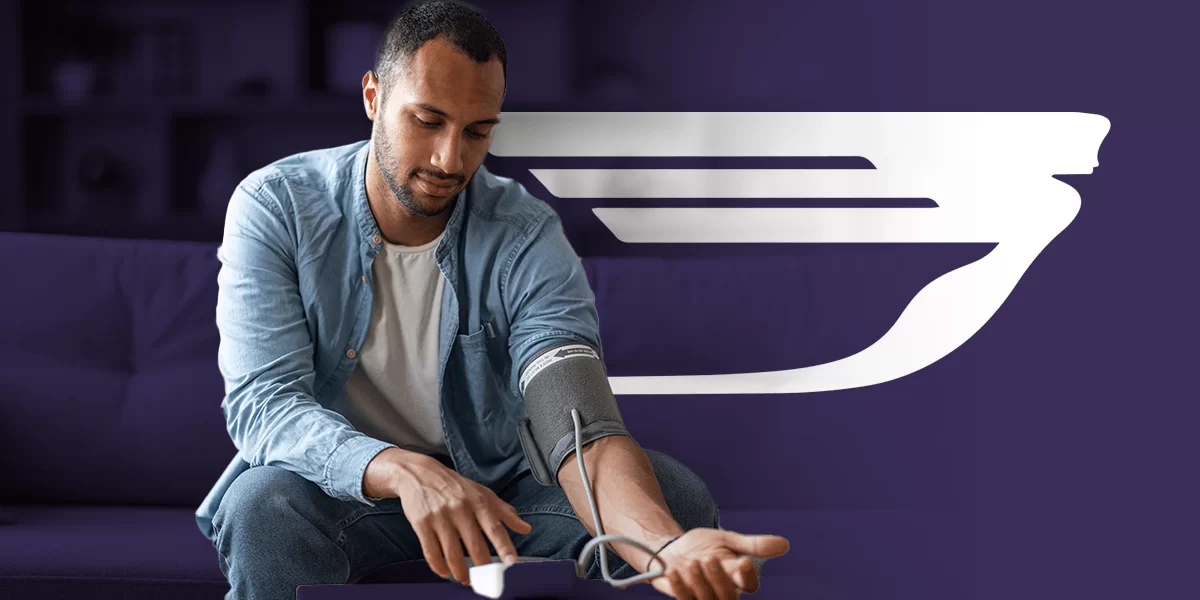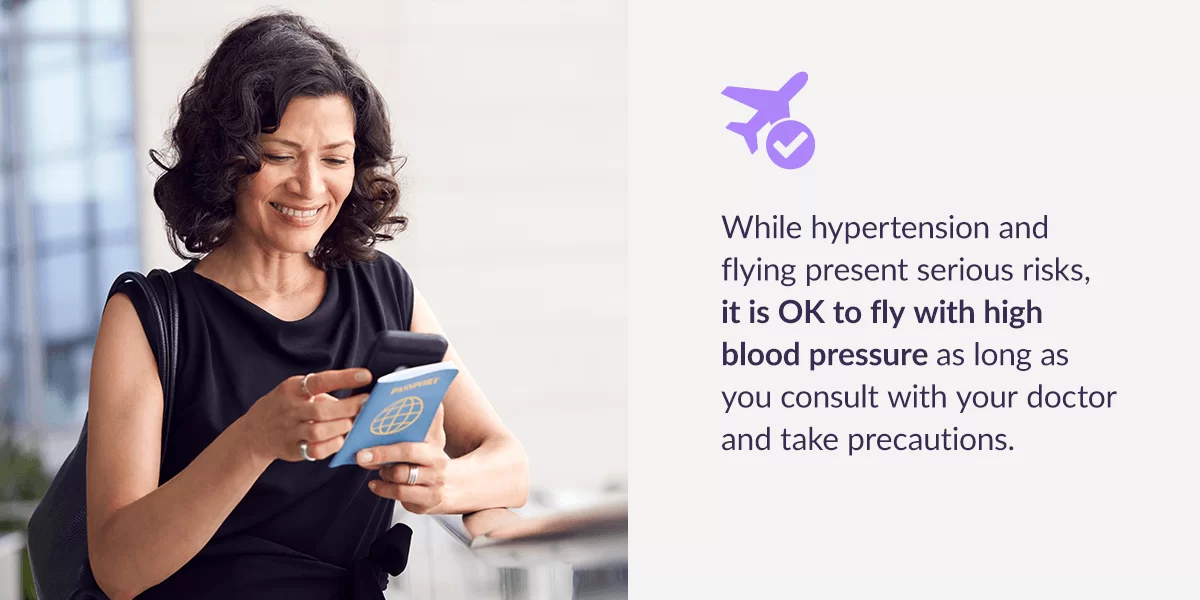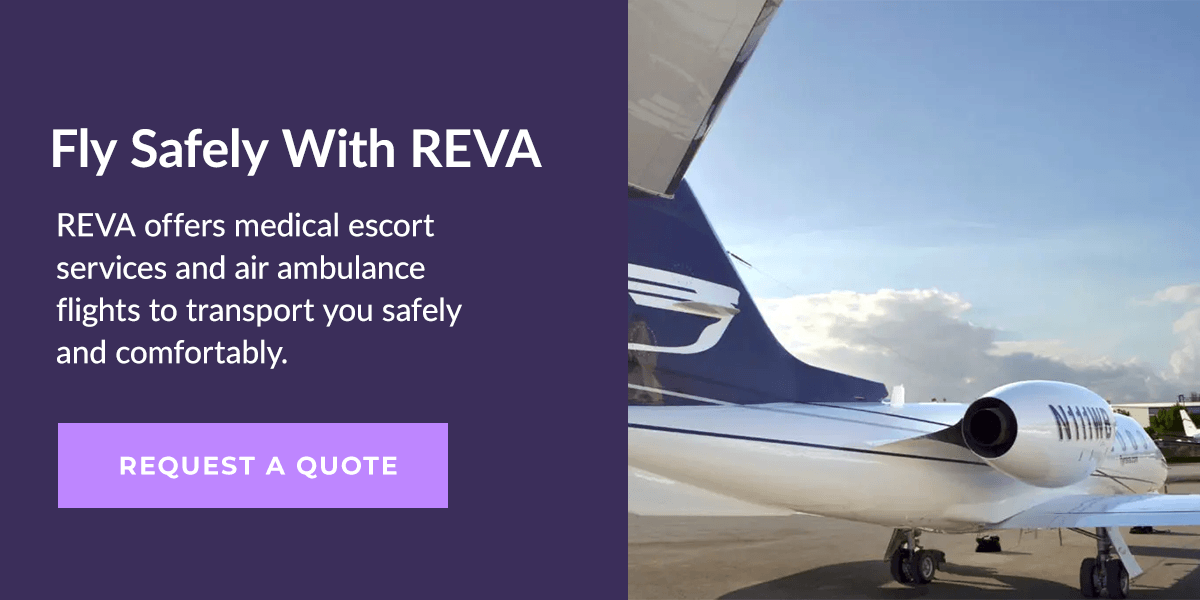You can fly with hypertension if you take precautions and travel with support. Flying with high blood pressure increases the risk of serious health concerns such as blood clots, pulmonary embolism, stroke and heart failure, but you can reduce these risks with the right guidance, monitoring and care.
Can You Fly if You Have High Blood Pressure?
You can travel with high blood pressure, but the specific precautions you must take depend on your overall health and hypertension stability. Consulting with your doctor before a flight is crucial because your medical provider can determine if it’s safe for you to fly and what you can do to remain safe.
The best way to travel with high blood pressure on an airplane is to fly with medical support. Taking a private air ambulance or traveling with a medical escort helps you access the care you need while in the air.
How Does Flying Affect Blood Pressure?
Flying with high blood pressure presents potential risks due to how high altitudes affect aircraft cabins. A cabin’s oxygen levels decrease once a plane reaches high altitude, forcing the heart to pump harder to move oxygen throughout the body. This extra labor increases stress and blood pressure. While this increase is typically non-concerning for most people, it can lead to serious health complications for individuals with hypertension.
Why Is It Dangerous to Fly With High Blood Pressure?
Flying with high blood pressure and no medical support can be dangerous because it presents the following risks:
Significant Spikes in Blood Pressure
Low oxygen levels, salty snacks, and alcoholic beverages can all increase blood pressure. If you have any apprehensions about air travel, anxiety and stress may also increase blood pressure, so it’s important to surround yourself with support.
Deep Vein Thrombosis
Deep vein thrombosis (DVT) involves a blood clot in one of the body’s deep veins. This most commonly occurs in a leg, but it can also develop in the pelvis or an arm. Flying with high blood pressure increases the risk of DVT because sitting for prolonged periods on an aircraft reduces circulation.
DVT requires treatment to prevent the clot from worsening or causing long-term vein complications such as post-thrombotic syndrome (PTS). PTS occurs when a vein’s valves incur damage, which can result in discoloration, pain, swelling, ulcers and scaling in the affected area.
Pulmonary Embolism
If left untreated, DVT can turn into a pulmonary embolism. If part of a blood clot breaks off, it can travel to the lungs and cause a blockage in the lungs. Recovery from a small pulmonary embolism is likely with the right treatment, but it may cause lung damage. A significant clot can be fatal if it stops the lungs from receiving blood.
Hypoxia
DVT can also lead to hypoxia, which refers to low oxygen levels in your body’s tissues. Hypoxia can cause the following symptoms and complications:
- Rapid heart rate
- Difficulty breathing
- Confusion
- A bluish tint to the skin
- Restlessness
Increased Risk of Serious Heart Conditions
Since flying can exacerbate high blood pressure, it also increases the risk of serious heart conditions such as stroke and heart failure. A stroke occurs when a blockage prevents the brain from receiving enough blood. It can also occur in the form of a burst blood vessel in the brain, and it can damage portions of the brain.
How to Fly With High Blood Pressure Safely
While hypertension and flying present serious risks, it is OK to fly with high blood pressure as long as you consult with your doctor and take precautions. The following solutions can help you enjoy a safe flight with peace of mind:
1. Fly With Medical Support
Having the right support system during a flight can help you reach your destination safely. Flight attendants receive training for basic life-saving measures such as automated external defibrillators and cardiopulmonary resuscitation, but they cannot provide medical intervention for most serious conditions.
Flying with a trained medical professional can help you remain safe and healthy during your trip, and you can do so in one of the following ways:
- Medical escort: A medical escort is a highly trained individual who can monitor your condition and provide medical intervention if necessary. REVA’s medical escort services provide you with safe, reliable care during your commercial flight so you can fly with peace of mind. A medical escort helps you remain comfortable, watching for signs of potential complications and providing the necessary care if complications arise.
- Air ambulance: An air ambulance flight is ideal for patients who need more intensive care during a flight. When you travel via an air ambulance, an experienced medical and flight team transports you from one location to another on a fully equipped medical aircraft. You may require an air ambulance if you have high blood pressure with additional health concerns.
2. Consume Only Healthy Food and Beverages During Your Flight
Avoiding salty snacks and alcoholic beverages can help you maintain healthy blood pressure on your flight. Before boarding a plane, purchase healthy snacks such as fruit, dried fruit or unsalted nuts. This way, you still have something to eat without consuming the salty options airlines typically offer. It’s also important to opt for water instead of alcohol while flying. Staying hydrated can help you prevent significant blood pressure spikes.
3. Move Around During Your Flight
Movement promotes healthy circulation, which can help prevent DVT. Stand up, stretch and walk around periodically if you can. Getting your blood flowing is especially important during longer flights.
4. Continue Taking Your Blood Pressure Medication as Prescribed
Blood pressure medication is allowed on flights, and taking it as your doctor prescribes it is important. Pack your medication in your carry-on bag so you can easily access it and take it at your regular time.
If you need to take any additional medications, such as motion-sickness pills, talk to your doctor first to ensure they are safe to take with your blood pressure medication.
5. Monitor Your Blood Pressure
Airlines allow passengers to bring blood pressure monitors on board, but they may have restrictions on certain types of batteries. If you fly with a medical escort, they will carry the necessary monitoring devices onto the flight and use them to determine your needs.
Why Trust Us
You can trust REVA with your in-flight medical needs because we prioritize safety above all else. We transport patients on the highest-quality medical aircraft, and our flight and medical teams receive ongoing training to provide the best care possible.
Our medical escorts and medical teams include registered nurses, flight doctors, registered respiratory therapists and critical-care paramedics. Whether you need to travel via an air ambulance or take a medical escort along on a commercial flight, you can count on REVA for safety and peace of mind.
Fly Safely With REVA
You can fly with high blood pressure as long as you take measures to monitor and protect your health during your trip. REVA offers medical escort services and air ambulance flights to transport you safely and comfortably.
Our medical escorts have the training and experience to monitor your blood pressure and overall health, prevent serious health risks and address potential complications if they occur. Contact us to request a quote or learn more about our air ambulance and medical escort services.



